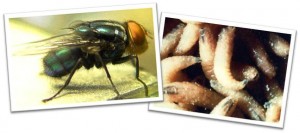
Several kinds of maggots infest the wounds of warm-blooded animals; however, the only one that feeds exclusively on live flesh is the screwworm, and Florida has a long history with New World Screwworm (Cochliomyia hominivorax). The adult flies of these flesh eating maggots migrated from central and south America to parts of the United States, and were common in Florida during the early to mid-1900s. Screwworm-related cattle producer losses in the southeastern United States were estimated at $20 million per year in the 1950s (imagine the cost in today’s economy!). Beginning in 1958, a coordinated, two-year, state-federal eradication program began in the southeastern United States. Even though these efforts eradicated the screwworm fly from the Southeast; there is constant danger of re-infestation. In Florida, we continue to see screwworm in imported animals. Since 2000, 12 imported animals with screwworm larvae infestations were identified in Florida. The larvae were eliminated before the fly could become established, but awareness and constant surveillance is the only way to prevent reintroductions of this pest into the United States (http://www.flsart.org/screwworm/index.jsp).

The Florida Department of Agriculture and Consumer Services (FDACS), Division of Animal Industry, the Florida State Emergency Operations Center (SEOC), and the Florida State Agricultural Response Team, have conducted first response training and provide educational materials to increase awareness about this and many other pests, disasters, and diseases that can affect Florida’s agriculture.
Anyone suspecting a screwworm infestation is urged to immediately contact:
Your local UF/IFAS County Extension Director
A local veterinarian
State Veterinarian’s Office
Florida Department of Agriculture and Consumer Services
Division of Animal Industry
8:00 a.m. – 5:00 p.m. (850) 410-0900
After hours: 800-342-5869
Email: rad@freshfromflorida.com
A website on the biology and distribution of the New World Screwworm, past eradication efforts, current eradication efforts, videos, and pictures, can be viewed at http://www.flsart.org/screwworm/information.jsp.
Further information about cattle parasites can be found in the following publication: External Parasites on Beef Cattle
 0
0
